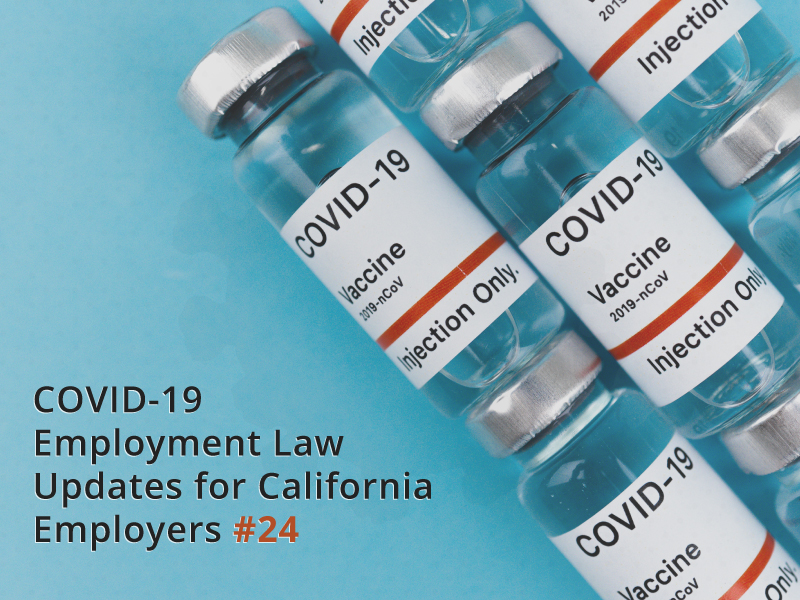Here is installment #24 of our ongoing series of COVID-related posts of interest to California employers.
EEOC Weighs in on Mandatory COVID Vaccines
We’ve posted a couple of times in the past about whether employers may require workers to be vaccinated against COVID-19. The EEOC, the federal anti-discrimination agency, has weighed in. The agency updated its guidance called “What You Should Know About COVID-19 and the ADA, the Rehabilitation Act, and Other EEO Laws” (here).
Scroll down to section “K” of the guidance for a discussion of vaccinations. Among the key takeaways:
- If the employer administers (or contracts with a third party to administer) a COVID vaccine, that’s *not* a “medical examination,” which would trigger obligations under the Americans with Disabilities Act.
- Although the vaccine itself may not be a medical examination, pre-vaccine screening questions could be a “disability-related inquiry.” Disability-related inquiries must be “job-related and consistent with business necessity,” which is a high burden to meet. Asking certain questions also may implicate the Genetic Information Nondiscrimination Act of 2008.
- Medical information related to administering the vaccines and obtaining information to do so must be kept confidential. That would be a state law requirement as well.
- Requiring proof of vaccination is not an ADA issue. But asking the reason why a worker did not get vaccinated could well be.
- Mandatory vaccines do raise ADA / disability discrimination issues when employees claim a disability precludes their taking a vaccine. Is flexing a mandatory vaccine rule a form of reasonable accommodation. It might be! So, that means an employer has to establish “undue hardship” or “direct threat.” An employer may enforce a general requirement even if an employee has a disability that would preclude taking the vaccine if the employer can establish the “direct threat” defense to reasonable accommodation. The guidance discusses this issue.
- Mandatory vaccines also raise potential religious discrimination issues, also discussed in the guidance.
- As the EEOC notes, a failure to obtain a vaccine could result in exclusion from the workplace but not necessarily discharge. Employers should consider whether there are alternatives and consult with counsel before discharging workers who have bona fide disability or religious bases to decline vaccinations.
So, employers in industries involving high degrees of contact with the public, or other risky factors certainly may consider mandatory vaccine policies. However, there may be workers who may avoid mandatory vaccine policies on a number of legal grounds. As with the “mask wars,” employers will be responsible for separating bona fide reasons to resist vaccinations from people who just don’t want a vaccine or who object on bases that the law does not protect.
California Department of Public Health Relaxes Quarantine Standards. Sort of.
Many employers require employees who test positive for COVID, or who have been exposed, to quarantine or at least to stay away from the workplace for a period of time. Some employer policies follow state and federal health guidelines, which require up to 14 days of quarantine time in the case of illness or positive tests.
Now, the California Department of Public Health has issued new guidance to local health departments. Memorandum (here). The memorandum states “asymptomatic close contacts (within 6 feet of an infected person for a cumulative total of 15 minutes or more over a 24-hour period) may discontinue quarantine after Day 10 from the date of last exposure with or without testing.” The memo also says that certain essential health care workers may discontinue quarantines after day 7 if they test negative on or after day 5, but only under certain circumstances.
The problem is that the memo also says:
- “Local health jurisdictions may be more restrictive than the above guidance.”
- “The Centers for Disease Control and Prevention (CDC) and California Department of Public Health (CDPH) currently still recommend a quarantine period of 14 days after COVID-19 exposure, based on estimates of the upper bounds of the COVID-19 incubation period. However, a 14-day quarantine can impose burdens that may affect physical and mental health as well as cause economic hardship that may reduce compliance. In addition, the prospect of quarantine may also dissuade recently diagnosed persons from naming contacts and may dissuade contacts from responding to contact tracer outreach if they perceive quarantine as onerous.”
Basically, this memo is saying that it’s really hard to require 14-day quarantines (and it is). So, you may be able to get away with a 10-day quarantine, although there is a small increased risk of infection.
But but … Cal-OSHA just issued regulations requiring a 14-day exclusion / quarantine period. We covered that here. Governor Gavin Newsom issued Executive Order N-84-20 suspending that part of the Cal-OSHA regulations in light of this Cal DPH memorandum (here).
It is very hard for employers to keep up with this ever changing set of rules. But before changing policies to shorten the quarantine period, employers must carefully review local ordinances, the nature of the particular business, any specific orders affecting the industry, the type of business and risks of infections, and evaluate whether their mitigation strategies in place will allow for reducing the quarantine time safely. Even the new guidance does not apply to certain businesses and industries where there is close proximity to high-risk individuals. What no one wants is for an employer to reduce quarantine time from 14 to 10 days, and then have a worker return early and cause an outbreak….



 Trending
Trending